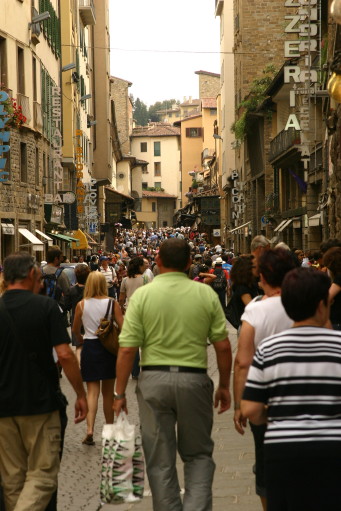
|
|
The American tourists didn’t seem to be there in Florence, but all the other countries’ representatives did. |





|
|
The American tourists didn’t seem to be there in Florence, but all the other countries’ representatives did. |
It’s Saturday, our last full day in Florence before we pick up the walking tour downstairs in our hotel. After breakfast, we walked down to the internet outlet (hardly a café) to check e-mail, and spent an hour there.
| ||||||
|
First stop was the Duomo, and everything there that we could get into. Why I took no pictures outside the building I don’t know, but Mark’s page has plenty.
The first four pictures to the left are just general interiors of the Duomo. The last is a nice twenty-four-hour clock I spotted, and I was particularly interested in the details of the face-layout. I think that this is the only clock I’ve seen whose hands go counter-clockwise, for one thing. And I suppose it makes perfectly good sense for noon to be at the top and midnight at the bottom. But it’s most interesting, I think, that the perfectly vertical position of the hand puts it between 12 o’clock and 13 o’clock, in other words, at an hour after noon.
Here in the Duomo, I had my next realization of false memory: I clearly recalled the floor here as being of plain white marble, and very uneven. And I thought that there were memorial plaques commemorating various famous personages, set into the floor. But you see that there’s nothing of the sort. The floor is certainly relatively new, could certainly have been replaced since 1978, but since there is no trace of my remembered plaques, I have to think that I was confusing the Duomo with some other place.
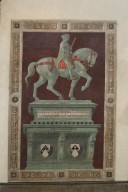
I did my very best to get a good shot of the extremely famous funerary monument painting to the right, by Paolo Uccello. It’s cleverly done to look like a depiction of an equestrian statue on which the horse’s trappings and the man’s cloak are of leather and fabric. Some of the descriptions of it on the web claim that it’s of “Giovanni Acuto”, but since the very first words in the Latin description say that the painting depicts Ioannes Acutus Eques Britannicus, that can’t be right. My first assumption was that his name had to be John Sharpe, but other web references say he was Hawkwood, and on reflection, I see what happened. The Italians heard “Hawkwood” as “a-koot”, and turned it into the closest Italian word that was appropriately complimentary. Be that as it may, I tried to Photoshop away the distortion that arose from my standing beneath the painting, and the result was of poor enough quality that there’s no Big image, just a small.
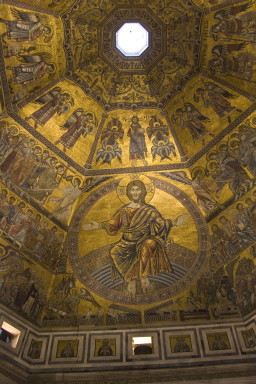
Admission to the Duomo had been free, therefore without any waiting line. But to get into the Battistero, you had to pay. Not much of a line, but it wouldn’t have mattered, because I really wanted to see the wonderful mosaic dome again. And once I did, I had my second experience of false memory, because in my recollection, the tondo with the seated Christ with his toes resting on the frame had grown to an immense and overwhelming size, taking up almost half of the dome. I can still see it my memory, in spite of being corrected by the much more interesting truth. (Big image, small.)
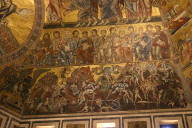
As with other places where there were very many works of art that I could have photographed, I didn’t try to record every beautiful thing that was here. That is the business of the art texts, after all. I just chose one or two things to give you an impression of what the whole was like. Here, on the left (big image, small), I especially liked the way Satan, or some other unsavory fellow, was devouring a sinner head-first, although a bunch of other creatures emanating from the devil’s person seem to be performing the same service.
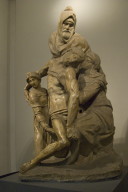
While we were in the neighborhood of the Duomo, we thought that we might like to climb up the dome, but the line was so long that we put that idea aside. But there was no way that I would go without seeing the Museo dell’Opera del Duomo. It’s got lots of wonderful things in it, including the original Ghiberti “Gates of Paradise”. Mark took several pictures of these, but on the principle I stated above, I left this to the art texts. I could not resist, however, taking a few snaps of the Deposition (“Florentine Pietà”) of Michelangelo, of which the best is to the right here. (Big image, small.)
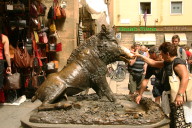
|
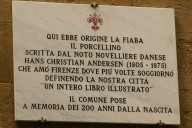
|
And now for a tourist attraction of an entirely different kind. The bronze boar to the left (big image, small) led me a merry chase through the web to find out its story. It seems that there is, or once was, a marble boar from the Hellenistic period, which got copied some time in the very early seventeenth century; this copy is now in the Uffizi, while the ancient original has been lost. The great Italian sculptor in bronze, Pietro Tacca, made a copy of the marble copy in 1612. This sat in the Mercato Nuovo in Florence, but so many people rubbed the nose that the original has been moved, to the Bargello I believe. The copy that you see here is obviously new—there is hardly any patina yet. I had trouble finding the exact date, but it seems to have been placed here about thirty years ago.
At any rate, HC Andersen wrote a tale, Metalsvinet (The Metal Pig, in some English translations The Bronze Pig) in which the Tacca bronze plays a significant role. I read the story recently, and it is distressingly maudlin. The Italians call the statue “Il Porcellino”, simply The Little Pig, and this seems to be the way they refer to the Andersen tale as well. The plaque nearby (lower image to the left, big image, small) explains that the tale had its origin here; the plaque itself claims to have been placed in only 2005.
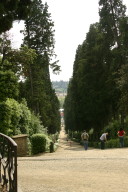
|
| Big image, small |
Then it was off to lunch, and a walk back towards the hotel, which meant passing by the Pitti Palace: this also constitutes the access to the Giardino di Boboli. I had heard the Boboli Gardens mentioned from time to time, and realized that it would be an Error to be staying so close to them and not go in and see what they were like.
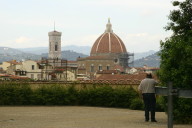
|
| Big image, small |
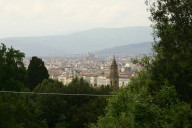
|
| Big image, small |
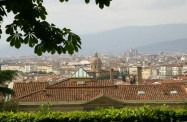
|
| Big image, small |
The Boboli is a large, fairly typical formal Continental garden, not really to my taste. But we did get some nice shots, especially of views back towards the center of town, and I certainly am glad that we went.
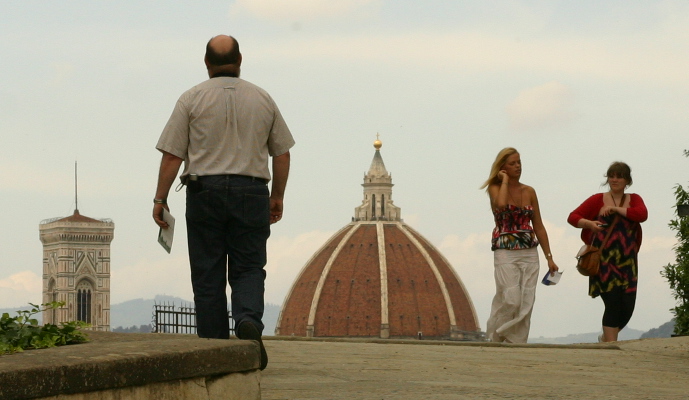
|
| Two lovely rounded forms |
From the Boboli, we went back to the hotel for a nap, and then around 7:30 we went looking for supper. We found a downscale place called Trattoria del Carmine, in the Piazza del Carmine, where we threw abstemiousness to the winds and had a full bottle of wine (as opposed to a 50-cl pitcher). It was our last night in Florence, after all.
Both of us started off with Prosciutto con Melone, then I had a nice thick Minestre con Fagioli—these were lentils, white beans, black beans, and one huge fava. Mark’s Primo was Risotto with Squash Flowers. Then Mark got grilled lamb, which he said was very dry, while I had amixed seafood fry, proposed to me by the boss, who said there weren’t enough makings of it to put it on the menu. It was wonderful. Very lightly battered, with several whole shrimp, a couple of squid heads with tentacles attached—one spat ink at me when I cut into it—lots of squid rings, and several whole little fish. I loved it.
No dessert for us, just an espresso for me, and off to our last night in our hotel. Next day would be the kickoff of our walking.
Next day’s pictures, previous day’s pictures. Return to the central Italy page; to the central travel page; to my home page.